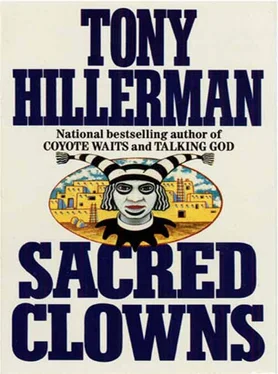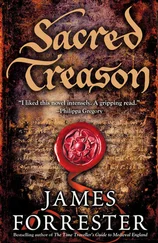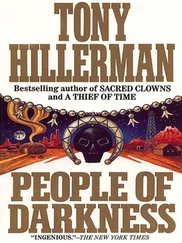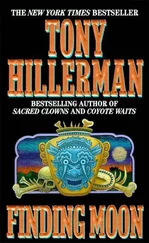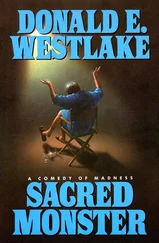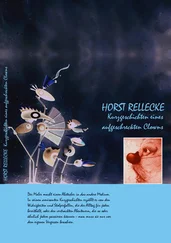She exhaled, picked up the purse again, and put it down.
“I don’t normally behave like this,” Leaphorn said. “Normally I’m pretty good at minding my own business. ‘Herd your own sheep,’ as my mother used to teach us. I’m Jim’s boss and I like him, and I worry about him sometimes.”
“I worry about him too,” she said. “But I think you have sort of misinterpreted things.” She produced a weak smile. “So did I. I was thinking in terms of Romeo and Juliet. The wrong families and all that.”
It took Leaphorn a moment to understand. “Clans,” he said, and made a wry face.
“Well, actually I think the clan business is all very ambiguous. Only my father was a Navajo. And it’s hazy on his side, too. But Jim, you know, I think maybe he’s not the marrying kind. So, even a hazy, ambiguous clan taboo can be useful.”
“Ummm,” Leaphorn said. What in the world was he doing, he thought, behaving just as Emma would behave, trying to be a matchmaker? This was absolutely none of his business. But he had found that he liked Janet Pete. He hadn’t expected to like her. And when you looked past his various flaws, you had to like Jim Chee, too. So, to hell with it, he would continue interfering. Emma wouldn’t believe he was doing this, but she would certainly approve.
“There’s something hard for normal people to understand about Jim Chee,” he said. “He’s an odd sort of idealist. He wants to become a practicing hataalii . He wants to be a bona fide traditionalist. To be a singer of the curing ceremonials. Not just to be a shaman, but to be a really effective one.” Leaphorn paused, looking for some general statement to sum this up, and his own attitude toward it. “It makes any sort of taboo more powerful than it would be to me – and probably to you. Officer Chee wants to save his people from the future.”
Janet Pete had listened to all this intently, without fiddling with her purse. Now she picked it up, and got up, and said, “I have to go.”
Leaphorn escorted her to the door. “Well,” he said, “I guess Officer Chee will show up again someday.”
“I guess so,” she said, and turned to look at him. “Were you serious about calling Mr. Streib?”
Leaphorn looked at his watch. “Right now,” he said.
JIM CHEE, born to the Slow Talking Dinee’, born for the Bitter Water Clan, whose real, ceremonial, and secret name was actually Long Thinker, awoke on the floor of Gracie Cayodito’s hogan just when dawn was invading the extreme eastern edge of the night. He was awakened by the voice of his uncle, who was standing outside the east-facing door of the hogan, singing his blessing song to the new day.
As Chee lay there, stiff from a night on this unyielding bed and still only half-awake, a second voice joined the husky baritone of Frank Sam Nakai. This one was older, cracked and scratchy – the sound of Hosteen Barbone shouting his greeting to the great yei Dawn Boy. Normally, Chee sang his own dawn prayer a bit later, after he’d started the coffee perking and the eastern sky was red with morning. He groaned, pushed himself upright, tucked in his shirt, and fished out from under it the buckskin medicine pouch, which contained his corn pollen. When in Rome, he thought, one does as the Romans do. He didn’t want to worsen the bad impression he had already made on these old men.
But later, with the sun up and the town of Window Rock in view through his windshield, he was pretty sure the perfect knowledge he’d displayed of the morning blessing hadn’t made any difference. The problem was the generation gap. The problem was theological. The problem was how one defined the concept of hozho , that idea of harmony which was the very root and foundation of the Navajo religion. This kind of problem wasn’t what he wanted when he’d gone back up the mountain to find his uncle again. He’d been in a crazy mood. Having that hit-and-run case turn out the way it did had been the last straw. Too much ambiguity, uncertainty, indecision. He wanted no more of that. He would go to the mountains and get a ruling on whether he could marry Janet Pete and still be a Navajo in the traditional sense. That took him through Farmington, right past the Quikprint shop. He slammed on the brakes, backed, pulled into a parking place. He had three different bumper stickers made, timing the process. It took almost thirteen minutes and, yes, it was expensive. Then he drove faster than the law allowed, making up for the lost time.
He’d wanted a favorable ruling. He had imagined the scene – an old, old man recounting the history of the Hunger People from the clan’s day one, proving that these people had never joined with his own ancestors, never made common cause, never did any of those things that would make them linked in blood. Then he would tell Janet. And what would she say? So what? You think you can tell me I’m taboo. Like maybe I had AIDS. And I don’t meet your high Navajo standards. And then you can come back and say I passed your test. Well, screw you, old friend . Or maybe the ruling would be negative. Even a negative ruling was better than this ambiguity. With that he could at least make a clear-cut decision.
But the great conference at the Cayodito hogan had drifted away from anything specific into the misty world of Changing Woman, First Man and First Woman, Talking God, and the great galaxy of other yeis .
Frank Sam Nakai had heard Chee’s truck coming up the muddy road and was standing in the doorway of his hogan.
“I have been asking and I have found the man who will know about the Hunger People and your own clans,” his uncle had said. “He lives over by Crystal. We will go and listen to what he will tell us.”
The man who would know was named Barbone. Like Nakai he was a hataalii , and like Nakai he was called “Hosteen” in respect for his years and his wisdom. But, of course, when they turned off the pavement of Navajo Route 32 and jolted down the road past the old Crystal trading post and up the crooked tracks into the aspen grove where Barbone had built his hogan, they discovered that Hosteen Barbone was not at home. His daughter, who seemed to Chee to be about seventy-five, said he had gone to the place of Gracie Cayodito to decide what sort of ceremonial was needed to cure a Cayodito grandchild of an illness.
On the road again, eastward out of the Chuskas to Route 666, north to the Two Grey Hills turnoff, then back into the Chuskas on the road which led – when and if weather permitted – to the Toh-Ni Tsa forest fire lookout tower. A badly used Chevy Blazer and a pickup truck were parked at the Cayodito place. Gracie was there. So was Hosteen Barbone, looking old enough to have a daughter over seventy. Beside Barbone, against the south wall of the hogan, sat a woman who looked even older than Barbone. Old Woman Mustache. Chee had heard of her somewhere – had heard that she was the wise person of the Streams Come Together Clan.
About an hour into the ensuing discussion, Chee decided that Old Woman Mustache either was mute or had fallen asleep. Hosteen Barbone covered the genesis of the Hunger People, how the clan had formed and gotten its name during Naahondzibd , the “Fearing Time” when the American army had joined the Mexicans and Utes in the war against the Dineh, and the men were afraid to leave on a hunt because they might return to find their hogans burned, their wives slaughtered, and their children taken by the soldiers, to be sold in the slave market at Santa Fe.
“They say that’s when the Hunger People began. They say that Kit Carson came through there, came through about where Many Farms is now, with horse soldiers and some Utes. They killed the people they caught there, and took the horses, and burned up all the corn and piñon nuts and blankets, and gathered up the children to sell them in Santa Fe. My grandmother said they got a hundred and fifty dollars for her. A rancher way down the Rio Grande bought her and had her baptized but she ran away and got back to the Jemez Pueblo and they sent her back to where her family was but her family was all gone. They say that only one man in that camp had a gun and when he tried to fight the soldiers with it, it wouldn’t shoot. The soldiers killed that one and just a few people got away up into the mountains. And they found other people hiding there, mostly women and children. They say they were from all over. From other camps where the soldiers had come through and cut down the orchards and burned the food and stolen the horses. A lot of them starved or froze to death during that winter, but Carson never did capture them so they didn’t go on the Long Walk to Bosque Redondo. They say that when the Americans released the Dineh from that prison and they came back to Dine’ Bike’yah, these people had their own clan. They say that since they came from all over they couldn’t name them with the place they came from, so everybody called them the Hunger People.”
Читать дальше
